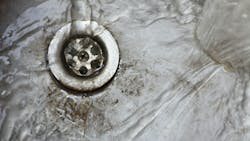Study identifies school buildings’ risk factors for lead in drinking water
New research on lead exposure in schools’ drinking water pinpoints some factors that contribute to exceedances of water lead level thresholds, according to a press release by the University of Massachusetts Amherst.
The most telling characteristic for schools in Massachusetts is building age, with facilities built in the 1960s and 1970s—nearly a third of the facilities tested—at the greatest risk for having dangerously high water lead levels.
The study, published in the American Water Works Association’s journal Water Science, compared water lead-level data to other characteristics that could influence these levels.
“Is it certain types of fixtures? Is it certain types of buildings? Is it certain places? Is the chemistry of the water supply? Is there anything about the water treatment process?” said Emily Kumpel, one of the study authors and assistant professor of civil and environmental engineering at UMass Amherst.
Building age was the most important contributing factor, for a few reasons. Legislation has been passed over the years to improve the safety of school water. The federal Safe Drinking Water Act Amendment in 1986 required the use of “lead-free” piping, solder and flux in buildings. The definition of “lead-free” was then refined to more stringent levels in 2011.
Kumpel explains that there is a clear “before” and “after” around each of these time points: 50% of water samples from buildings constructed in 1986 and earlier had a water lead level of 2.1 ppb or higher and 13.7% of samples were greater than 15 parts per billion (or 0.0015 mg of lead per liter of water). After 1986, this declined so that half of samples had one ppb or less of lead, and only 4.6% of samples had lead levels higher than 15 ppb.
Importantly, these results represent water lead levels captured at “first draw,” meaning the water had been stagnant in the pipes overnight. The pattern was similar when looking at samples after the pipes had been flushed for 30 seconds, though less pronounced and with significantly lower lead levels after flushing.
Buildings constructed in the 1960s and 1970s—about 30% of all schools tested—were the most likely to have faucets, water fountains or other fixtures with elevated water lead levels at first draw. Half of the first draw water samples taken from schools built in these decades had lead concentrations at or above 2.8 and 2.9 ppb respectively. Plus, 16% of fixtures in 1960s buildings and 19.5% of fixtures in 1970s buildings had first draw levels over 15 ppb.
“That means that if you go into a facility built in the ’60s or ’70s and are the first one to get a glass of water in the morning or after a long school break, you’d have a high chance of it having a dangerously high level of lead. However, if the tap was flushed or had been used throughout the day, this would drop substantially. This is why flushing or other remediation actions are important,” Kumpel says.
Schools built in the 1950s and 1980s were also at slightly lower, but still elevated, risk.
Kumpel explains that this reflects certain construction decisions that were made in particular places at particular times. She also notes that trends in Massachusetts likely extend to other parts of New England that aren’t so geographically different and likely had similar building trends and best practices over the years.
Testing results for the lead and copper concentrations in schools’ drinking water is available in a public database.
